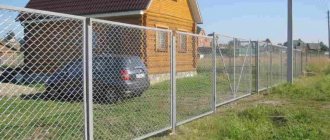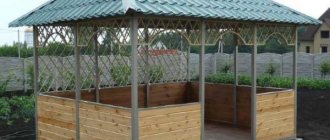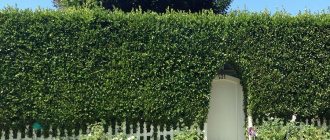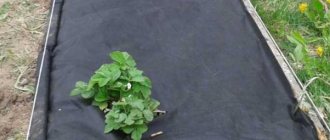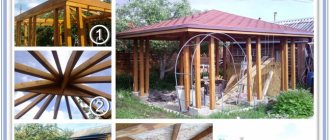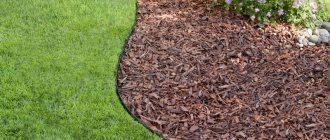Chain-link mesh is good for fences installed on summer cottages and on the territory of private households as a boundary between neighboring plots. It does not provide continuous shade and does not interfere with air circulation. The scope of its application does not end there.
More specific information about the types of chain-link mesh with visual photos, cell sizes, advantages and disadvantages will be given in the article.
How to make a chain-link mesh
For a more complete and clear understanding of the structure of the chain-link mesh or its analogues, you need to study the entire production process of these meshes.
Let's take a closer look at the features and nuances of production:
- When producing such material, high precision is required, which is ensured using special equipment. It is worth noting that such machines make material of the required size, correct shape, with high strength and good appearance.
- All machines that produce meshes are equipped with computers that fully automate the manufacturing process.
- For some meshes that have specific sizes and sections, special machines are required that perform resistance welding.
It is worth noting that such seriousness of this process is not accidental, because each network must have high-quality parameters.
In this regard, only reliable materials are used, including:
- A variety of wires that have different markings for each type of network.
- Hot contact types of chain-link mesh.
- Types of chain-link mesh that have improved strength parameters and undergo heat treatment.
Comparison of prices and properties of mesh materials
To get an idea of which chain-link fence for arranging a summer house is better based on a number of factors, it is recommended to make a small comparison of the costs and basic properties of various materials.
Price category
The cost of mesh fabric can vary greatly, ranging from 60 to 300 rubles/sq.m. m, which is influenced by the main parameters of the material: cell dimensions, wire diameter, type of protective coating.
The cost of a mesh fence depends on several parameters: the mesh material, the mesh size, the thickness of the wire in the mesh and the method of its attachment.
The most affordable is non-galvanized mesh. This is followed by galvanized material. Plasticized mesh fabric is more expensive than others, as it is characterized by a number of important properties.
Quality, degree of reliability
Again, the polymer-coated option is more characterized by durability and sufficient reliability. Such properties allow the material to be used for decades.
Accordingly, the thinner the mesh, the cheaper and lighter it is, but the less strong and durable it is.
This is due to the presence of a polymer layer, which is more difficult to deform than brittle galvanization.
Construction speed
A garden fence made of mesh in different designs is built using similar technologies. However, the non-galvanized version requires additional painting, which increases the installation time of the fence.
Accordingly, it is more profitable to use galvanized and polymeric materials, since a fence made of these types of mesh does not require additional coating with a protective composition, which saves time.
What types of chain-link exist?
The emergence of new types of structures and construction work has led to the emergence of various types of this material. Classification is carried out according to many criteria, including coating, shape and size of cells.
According to the variety of coverage of networks, the chain-link is usually distinguished:
- Galvanized chain-link network - this coating differs from all others only in its service life, since such a network can last up to forty years. The mesh is coated with zinc.
- Non-galvanized chain-link network – this type of network is considered the most short-lived, as it can last up to a maximum of ten years. The mesh is not coated with zinc.
- Polymer chain-link mesh - this mesh is designed for more difficult environmental conditions. Moreover, there are a huge number of color palette choices. So, with the help of such a mesh you can not only protect the necessary area, but also decorate it in the color of the design, for example, your yard.
According to the shape of the mesh, the chain-link is distinguished:
- Diamond-shaped - a chain-link with diamond-shaped cells. They can be small, they can be big.
- Square - chain-link with weaving cells in the form of squares. Such cells can be large or small.
It is worth noting that diamond-shaped chain-link is the most common. Buyers find it more familiar to look at.
The mesh size of the chain-link mesh refers to the distance between the weaving. There is fine weaving and wide weaving. You can buy mesh with sizes ranging from 5 mm to 1 cm.
Classified by purpose:
- Masonry networks.
- Road networks.
- Concrete and asphalt concrete networks.
- Networks for concrete base floors and reinforcement of certain types of screed.
- Chain-link mesh for fence structures.
- Networks for strengthening engineering structures.
Prices for mesh and ready-made fences in Moscow and St. Petersburg
The cheapest chain-link mesh will cost from 30 rubles. for 1 sq. m., more durable - over 500 rubles. for 1 sq. m. The cost of installing a 1.5 m chain-link fence is from 364 rubles. for 1 linear meter (l.m.), with a height of 2 m - from 450 rubles. for 1 p.m.
The price for welded fabric measuring 50*50*3 mm in 0.5*2 m cards starts from 78 rubles. for 1 m, with dimensions 100*100*5 mm in cards 2*3 m increases to 115 rubles. for 1 m.
Installation of finished sections 2.5 m wide from galvanized mesh with cells 50*50 mm, 2 m high will cost 1150 rubles. Sections of welded wire decorated with patterns will cost twice as much.
With a competent approach to choosing fencing mesh, you can find high-quality material at an affordable price that will last a long time.
What materials is the chain-link made of?
This classification is worth noting separately, because it is by it that the type of chain-link mesh is determined.
In this case, the following are distinguished:
- Chain-link mesh made of metal. These are the most common materials, because it is the easiest to make strong meshes from, which have high thermal and electrical conductivity. With all this, it is worth understanding that such networks are large in size. The manufacture of such networks involves the use of iron, iron alloys, steel and steel alloys.
- Chain-link mesh made of stainless steel. These models are in demand because of their versatility, because it can be used both indoors and outdoors. At the same time, this representative has the longest service life and high strength.
Also, due to the flexible material, such networks are the easiest to adapt to the structure.
Expert advice
If the financial issue is acute, then the average option, which combines sufficient reliability and reasonable cost, is a galvanized type of mesh. Its service life is quite long, provided that it is treated with care during transportation and installation, as well as during further operation.
However, the best option of the three types considered is still plasticized material. Its service life is much longer, and its external characteristics are much higher.
All these factors together will allow you to select the best material for certain conditions.
In what areas is chain link used?
When studying these materials, one cannot fail to mention the areas in which they are used. This includes:
- Creation of reinforced concrete structures and road surfaces.
- Work on the construction of the bridge and its supports.
- Production of slabs or panels from concrete material.
- Installation work of thermal insulation materials.
- Installation work of heated floors.
- Creation of fortifications for foundations.
- Work on creating the frames of a greenhouse or greenhouse.
- Creating a fortification for a ditch or pit.
- Chain-link mesh is used in many areas.
Installation of pillars
To install the posts with a garden drill, you need to make holes up to 80-120 cm deep. Their size depends on the characteristics of the soil - less dense soil will require more drilling. The hole must exceed the diameter of the support. A cushion of crushed stone and sand 100 mm thick is placed on the bottom.
At the next stage of installing a mesh fence, the supporting supports are attached. To do this you need to prepare the pillars:
- metal supports are cleaned of rust and stains, welding areas are cleaned, the surface is primed and painted;
- wooden poles must be treated with an antiseptic.
Supports should be installed taking into account the possibility of soil swelling in the spring. They are buried 200 mm below the freezing point of the soil. Corner supports are installed first. The support, treated with anti-corrosion mastic, is mounted in the hole and filled with concrete.
New Year in the yard: how to beautifully decorate the yard with your own hands!- How to make a modern landscape design with your own hands?
Microgreens at home
To prepare the solution, you need to mix sand and cement in a ratio of 1 to 2, mix, then add 2 parts of crushed stone, and after adding water, mix again. The supports are often first placed at 350-400 mm, and then driven in with a sledgehammer to the required depth. At the level of the base pillars, intermediate pillars are attached in a similar way.
You can also start installing the fence by filling the holes with supports with layers of rubble, soil and again rubble stone. Each layer is carefully compacted.
What are the advantages and disadvantages of chain-link?
Like all building materials, chain-link networks have a number of advantages, including:
- High strength indicators.
- Possibility of creating various fortifications.
- Convenient and simple installation and operation process.
- High resistance to temperature changes.
- Low fire hazard.
- Possibility of strengthening various structures.
With all this, such networks have only one drawback - corrosion.
Main types and parameters for choosing material
There are three types of chain link:
- simple (without additional processing);
- galvanized and reinforced;
- galvanized with a special polymer coating.
The first type is usually used in areas where metal contact with the environment is not expected. Most often, such black mesh is used during plastering work as the main reinforcing material. In this case, costs are significantly reduced compared to conventional plaster reinforcement, while the mesh is convenient for installation.
Galvanized mesh with a special polyvinyl chloride coating
Galvanized mesh is used in all areas, including construction and manufacturing. It has first degree anti-corrosion protection and is able to withstand high and low temperatures for a long period of time. At the same time, galvanized material does not require constant painting; in this case, the paint serves only a decorative function.
The most expensive and reliable type of chain-link is galvanized mesh with a special polyvinyl chloride (PVC) coating. It does not require additional processing, has high anti-corrosion protection and maximum durability. It is used primarily as a fencing area in summer cottages, residential and commercial complexes. Regardless of the coating, the mesh is made from low-carbon steel of medium quality using special technology, which contributes to its affordable price on the market.
Photo of mesh netting
Application of galvanized mesh
Let's consider where in life a chain-link mesh with a galvanized coating is used:
- As fencing for various areas. Usually these are garden plots, dachas, parking lots, closed and guarded areas.
- Construction of partitions in various areas.
- It is used to build enclosures and fences for domestic animals.
- Chain-link mesh is used in construction work for sifting bulk components, as a reinforcing layer when creating monolithic concrete structures. This is much more profitable than using metal reinforcement as a reinforcing frame.
- Wire backing is often used when plastering various surfaces. In this case, galvanized mesh with small cells is used.
- For the construction of road surfaces, production of coating slabs. The mesh is placed inside the concrete structure.
- For securing rock in mines and mining industries.
- As an emergency means when moving a car in difficult conditions. If a car is stuck in sand, mud, or snow, then a piece of chain-link placed under the wheels will allow it to get out of the danger zone without any problems.
- For the construction of gabions as a load-bearing frame. For this, a mesh with a metal thickness of 5 mm is used. The cell diameter used is 10 x 10 cm. Gabions are filled with stones, as a result of which it is possible to form three-dimensional structures of various shapes.
Grid height and width
The indicator for the width of the roll is the height of the proposed fence with an allowance. Correct calculations will allow you to take a mesh of the height that the fence covers. However, if there is a mistake, this material can be easily straightened out by simply cutting through the unnecessary cells.
When purchasing, you should be aware that you need to add at least another 20 cm to the width. This will be the distance between the bottom of the fence and the ground. It is not recommended to install the chain-link close to the ground, therefore an allowance is needed.
Typically the fence height is 1.5 meters. It is illuminated by the sun and does not interfere with the view, protecting the boundaries of the site. It is less common to buy a 1.2 m roll. The fence comes out lower than required.
So, the width of the mesh roll is equal to the height of the future fence. The length of the roll is taken into account, which is standard 10 meters.
Useful Features of a fence made of double-sided corrugated sheets (corrugated sheets) and its varieties
Fence installation sequence
Installation of a chain-link fence consists of 2 stages: installing supports and tensioning the mesh. Before purchasing the material, the site is measured and marked. Experts advise doing this before purchasing in order to accurately calculate the number of posts and the length of the mesh.
Installation of supports
To install the supports, using a garden auger or an ordinary shovel and crowbar, make holes 80 - 120 cm deep.
The diameter of the holes depends on the cross-section of the pillars. The hole should exceed the size of the support, but not by much, so that the installed pole does not become loose.
When calculating the depth of burial of supports, it is worth considering that in the upper part the pillar should rise above the mesh by 10 cm.
That is, if the height of the roll is 1.5 m and the height of the column is 2.5 m, then they bury it at 80 cm.
The corner posts and supports to which the gate will be attached are deeper. All posts must be positioned vertically.
- Pit preparation depends on the quality of the soil on the site. On sandstones and loams, it is better to lay a sand and gravel cushion on the bottom and fill the pillar installed inside with concrete.
- But sometimes the space between the soil and the support is simply covered with small stones and compacted. This installation option is acceptable on dense, clayey soils.
Mesh installation
The procedure for tensioning the mesh begins only after the concrete has hardened, no earlier than 2 days later. The order of work depends on the method of fastening the material.
Tensioning without guides
The sequence of actions when making a simple tension fence is as follows:
- The roll of mesh is unpacked and one end is secured to the first post. The installation method depends on the material of the support. The mesh is hung on specially welded hooks or secured with ordinary nails. You can also use clamps.
- Carefully unwinding, pull the mesh to the next post. The canvas must be stretched as much as possible so that it does not sag later.
- A rigid wire is pulled through the upper and lower edges of the mesh. It is also fixed to supports.
To prevent the corner posts from collapsing after tensioning the mesh, they are secured with A-shaped supports made of additional pipes.
Tensioning along guides
To make such a fence, after installing the supports, transverse crossbars-guides are pre-installed between them, on which hooks are located or nails are hammered for hanging the material.
The further procedure is similar to installing the mesh without guides.
The roll is unpacked, attached to the first post, and then pulled to the next.
In the space between the supports, the mesh is fixed to the guides.
Steel reinforcement can be used as guides. It is pulled between the cells of a stretched mesh and welded to the pillars. This ensures reliable fixation of the material in a tense position.
Features of installing a fence from sections
The technology for installing a sectional fence consists of welding frames from metal corners or profiles and filling the internal space with a chain-link mesh. This type of work requires special tools and certain skills.
As an option, you can purchase ready-made sections, which are often equipped with support posts. The price of such a fence will be much higher, but installation is much simpler and the quality of the structure is better.
Sectional fences are recommended to be installed in areas with uneven terrain. In this case, for each individual section, a section of a certain height is made so that the fence is level along its entire length.
Igor
Builder
If there is a slope on the site, the sections are also installed strictly horizontally, but in a stepwise manner. For this design, you will have to vary the length of the pillars. The lower they are installed, the longer their length should be.
— Igor Stroitel
The distance between the posts is selected so that the gap between the mesh and the soil is not very large and uniform along the entire length of the fence. That is, the steeper the slope, the smaller the gaps between the supports.
When calculating a fence made of sections, it is necessary to divide the perimeter by the width of one segment.
A properly installed fence made of high-quality chain-link mesh will last for decades. If such a fence does not seem very attractive, it can be decorated with climbing plants or interesting and unusual elements.

